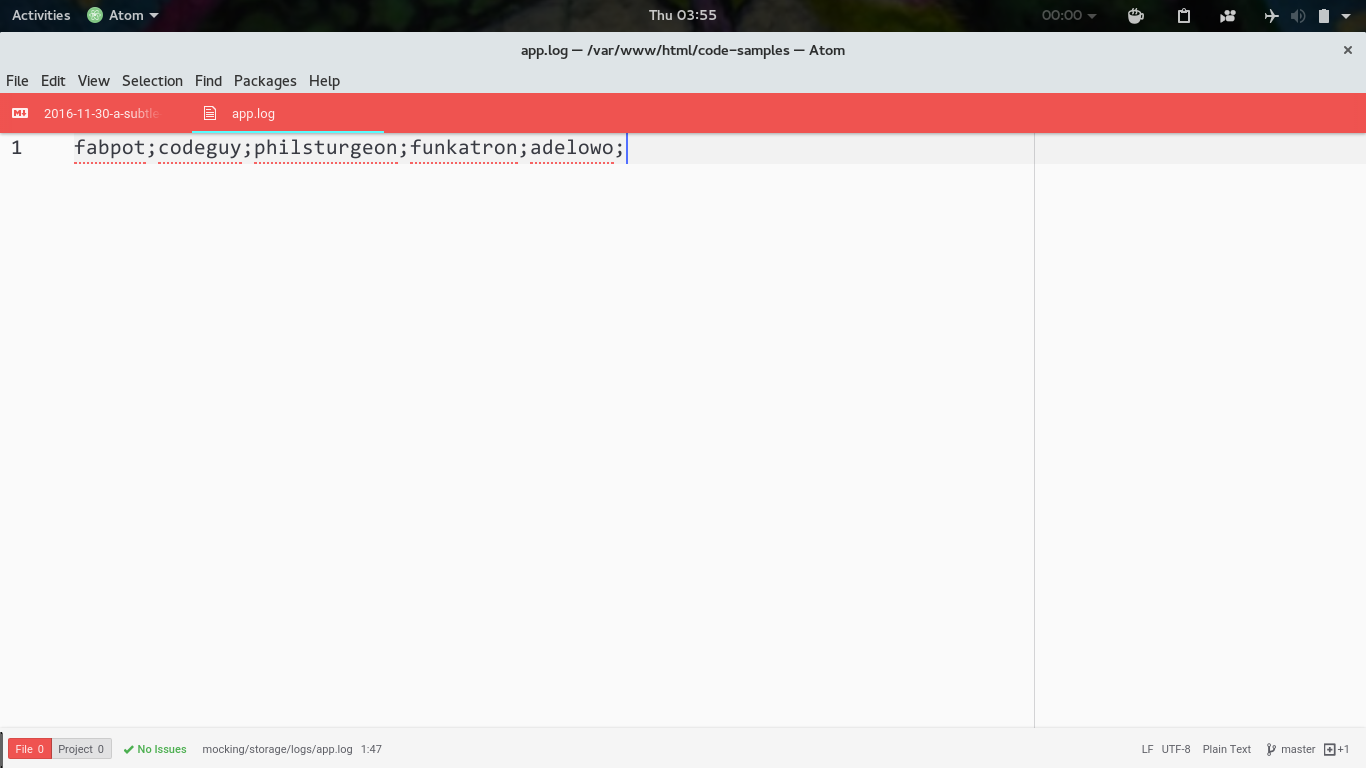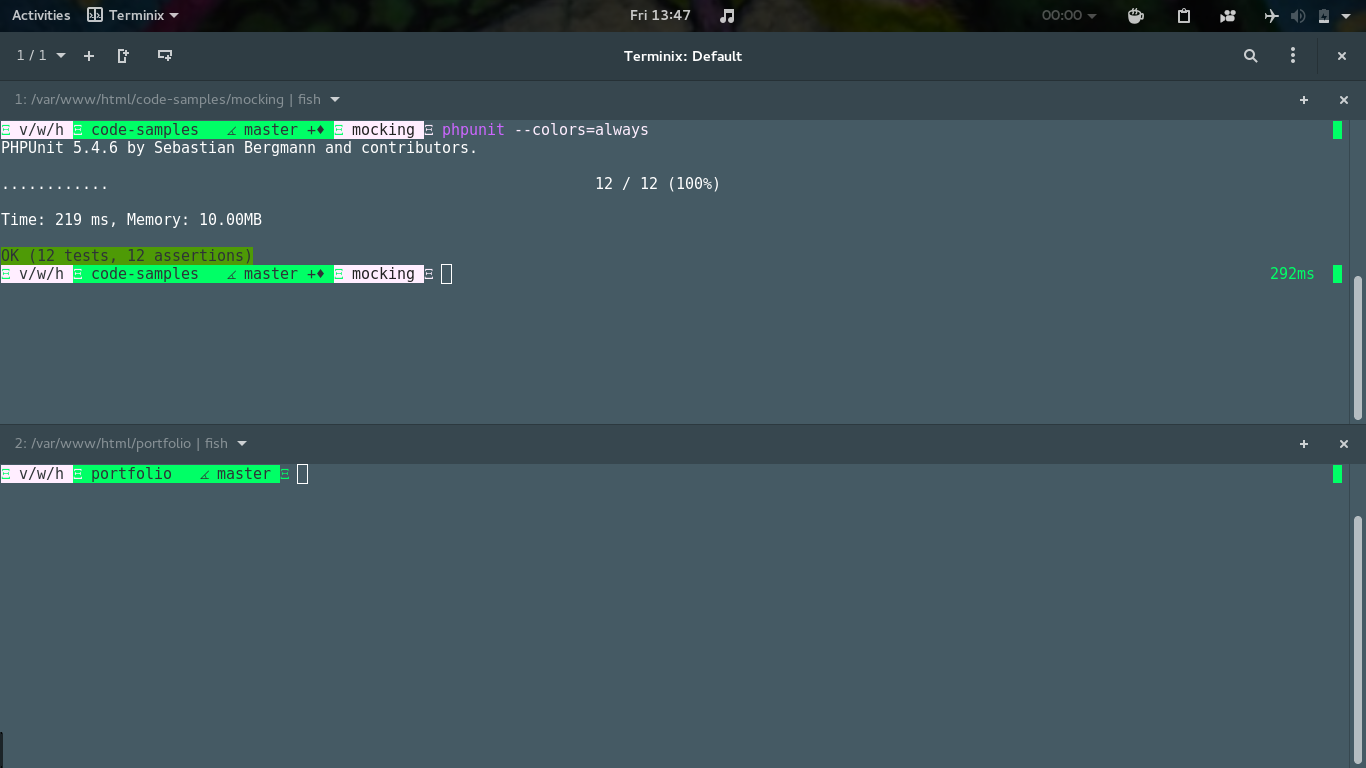Dec 02, 2016
An introduction to Mocking
10 min read
What is Mocking ?
Mocking is simply the process of replacing an object with a fake that can act as a replacement.
Why Mock ?
The major reasons why we mock are Dependency elimination and removal of side effects. Think things like databases, 3rd party API requests and network requests, code that has to hit the filesystem.
This stuffs aren't always guaranteed to be available or can prove tedious to set up (an internet connection for example) and even when they are (a
logger that writes to the filesystem for example), they always tend to make your tests run extremely slow which is .
The F in Uncle Bob's rule of unit testing (F.I.R.S.T) stands for Fast.
Unimplemented code can also be mocked. But i'd only recommend this if there is an interface the code is to adhere to.
Mocking boils down to the fact that a unit test is meant to be run in isolation so as to properly verify it's functionality. When you aren't testing in isolation, it is no longer a unit test but an integration/functional test, then mocking would be a terrible idea since the latter is meant to test the entire application as a whole.
Mocks versus Stubs
This terms are usually thrown around and it's nice to make a distinction between both of them. In fact, both are actually categorized together. They are called Test Doubles.
Stubs are a set of fake/dummy data in other to make a test pass WHILE Mocks (object) are simply "fakes" that simulate the behaviour of another object in a way that is controlled by you, the tester. Mocks may (not) have stubs.
Getting started
The defacto tool for this - in PHP - is Mockery even though PHPUnit ships with it's own implementation. That can get too verbose.
To install mockery, we'd have to pull it in from packagist by running
cd somedirectory
composer require --dev mockery/mockeryIf you want to make use of PHPunit's default mock implementation, you can find an example here
How do i mock
In this section, i would be showing 2 practical use-cases of a mock. The sample code includes ;
- A Logger.
- An app that communicates with the Github API. (This would be in the second part of this post)
The Logger
After hitting Github's api, we want to log the username that was searched for. Probably to implement some sort of most searched users feature.
The way this would work is by appending some sort of separator - ; - to each username in the log file.
With this, we end up with a file that has it's content similar to this : fabpot;funkatron;philsturgeon;adelowo;codeguy;.
Then we can run through the entire file content, run some logic to get the username that appears the highest number of times.
This obviously is a stupid idea but it passes the idea through.
In other to pass this idea through, I would be providing code samples that show our logger in two states : The premock stage and The postmock stage.
Both stages work as expected and have unit tests.
I have put up the code for both stages on github
The Premock Stage
<?php
namespace Adelowo\Mocking\PreMock;
class Logger
{
const LOG_FILE = 'storage/logs/app.log';
public function log(string $username)
{
$status = false ;
$userNamePlusSeparator = $username.';';
if (file_put_contents(self::LOG_FILE, $userNamePlusSeparator, FILE_APPEND)) {
$status = true;
}
return $status;
}
}<?php
namespace Adelowo\Mocking\Tests\PreMock;
use Adelowo\Mocking\PreMock\Logger;
class LoggerTest extends \PHPUnit_Framework_TestCase
{
protected $logger;
public function setUp()
{
$this->logger = new Logger();
}
/**
*@dataProvider getDevelopers
*/
public function testLoggerWorksCorrectly($dev)
{
$this->assertTrue($this->logger->log($dev));
}
public function getDevelopers()
{
return [
["fabpot"],["codeguy"],["philsturgeon"],["funkatron"],["adelowo"]
];
}
}So we have written and tested our logger. Awesome, we are green. But we have a problem, we touched the filesystem 5 times. What if we had to do this 15, 20, 50 times. Our tests' would take longer to run. Initially, that may not sound as a bad idea but :
Tests should be fast. They should run quickly. When tests run slow, you won’t want to run them frequently. If you don’t run them frequently, you won’t find problems early enough to fix them easily. You won’t feel as free to clean up the code. Eventually the code will begin to rot --- Uncle Bob (F.I.R.S.T)

Ok, that was a soft argument.
From an OO point of view, our Logger class does too much thus violating the Single Responsibility Principle. How about we extract the file_put_contents part to a
class of it's own - a class whose sole responsibility is interacting with the filesystem. Then our logger would just be a logger.
We also are not interested in testing the file_put_contents (this goes back to side effects), it is a BIF and most likely have it's own tests from PHP's core team (plus it is proven).
How about a rewrite ?
Postmock Stage
As said above, we can (and really should) split our Logger into a Logger and a FileSystem object. Let's see what that looks like after the extraction.
<?php
namespace Adelowo\Mocking\PostMock;
class FileSystem
{
protected $path;
public function __construct(string $path)
{
$this->path = $path;
}
public function append($data)
{
return $this->put($data, FILE_APPEND);
}
public function put($data, int $flag = 0)
{
return file_put_contents($this->path, $data, $flag);
}
}<?php
namespace Adelowo\Mocking\PostMock;
class Logger
{
protected $fileSystem;
public function __construct(FileSystem $filesystem)
{
$this->fileSystem = $filesystem;
}
public function log(string $username)
{
$status = false;
$userNamePlusSeperator = $username . ';';
if ($this->fileSystem->append($userNamePlusSeperator)) {
$status = true;
}
return $status;
}
}This is pretty much straight forward. We have a dependency on a Filesystem object and on the log method call, we append the username that was searched for to the file.
So how does this differ from the original implementation ? The major difference is that we are now injecting our dependency - FileSystem - into our Logger.
This is to allow maximum testability as the built in file_put_contents doesn't have to be called (remember we are going to mock that. And also prevent the side effect it brings alongside it's usage).
Well let's write some test.
<?php
namespace Adelowo\Mocking\Tests\PostMock;
use Mockery;
use Adelowo\Mocking\PostMock\Logger;
use Adelowo\Mocking\PostMock\FileSystem;
class LoggerTest extends \PHPUnit_Framework_TestCase
{
protected $logger;
public function setUp()
{
//The array below stands as the argument(s) for the FileSystem's constructor
$fileSystem = Mockery::mock(FileSystem::class,["storage/logs/app.log"]);
$fileSystem->shouldReceive("append")
->andReturn(true);
$this->logger = new Logger($fileSystem);
}
public function tearDown()
{
Mockery::close();
}
/**
*@dataProvider getDevelopers
*/
public function testLoggerWorksCorrectly($dev)
{
$this->assertTrue($this->logger->log($dev));
}
public function getDevelopers()
{
return [
["fabpot"],["codeguy"],["philsturgeon"],["funkatron"],["adelowo"]
];
}
}And we are green again without much ado - The FileSystem class doesn't need to be fiddled with again plus we have gotten rid of the side effects .
But hey, how am i sure the FileSystem class is working ? Nice one. It should have it's own tests.
Watch closely, this is probably the most important part of the tests. Don't get carried away. Whatever you mock MUST have it's own test(s).
<?php
namespace Adelowo\Mocking\PostMock;
use Mockery;
class FileSystemTest extends \PHPUnit_Framework_TestCase
{
public function tearDown()
{
Mockery::close();
}
/**
* @dataProvider getTopPhpers
*/
public function testFileAppendingIsWorking($phper)
{
//`makePartial` means we have a mock (a partial mock")
//What this means is "We have a mock but we want it to act exactly the same way the original object acts except when we tell it to do otherwise".
$file = Mockery::mock(FileSystem::class,["storage/logs/app.log"])->makePartial();
$file->shouldReceive("put") //We want only the `put` method to be mocked
->with($phper, FILE_APPEND) // the `put` method must receive the value of `$phper` and the `FILE_APPEND` constant
->once()
->andReturn(true);
$this->assertTrue($file->append($phper));
}
public function getTopPhpers()
{
return [
["fabpot"],
["philsturgeon"]
];
}
}Running phpunit again should still give us green and checking the app.log shows we didn't touch the filesystem.
The
app.logfile would have this values :fabpot;codeguy;philsturgeon;funkatron;adelowo;. This is so as the premock tests touched the filesystem. You can clear that out and run only the tests of the post mock stage by runningphpunit tests/PostMock/

Mocking is a big deal when it comes to testing. Easy to get started with. Easy to love. Easy and prone to misuse.
I hope this has given a little insight into how mocking works. I hope to write the second part soon.
Update : The second part is accessible here
Update => Dec 9
Just as it has been pointed out in the comments, the put method should have it's own tests - i kind of skipped this since i was only interested in mocking but some paragraphs up,
i actually talked about mocks having their tests. There are actually three approaches to testing the put method :
Touching the filesystem for real. If using this method, you would have to create a temporary directory in the
setUpmethod, then clean up/delete the directory in thetearDownmethod. This has the disadvantage of making your tests run slow but some tips for speeding it up has been talked about extensively in the comments.Virtually touching the filesystem (recommended). Your test for the
putmethod would still touch the filesystem but this time, it would be a mocked filesystem. Below is an example taken directly fromphpunit's manual - which uses vfsstream - that shows the usage of a virtual filesystem instead of manually creating and deleting temporary directories.
<?php
use PHPUnit\Framework\TestCase;
class ExampleTest extends TestCase
{
public function setUp()
{
vfsStreamWrapper::register();
vfsStreamWrapper::setRoot(new vfsStreamDirectory('exampleDir'));
}
public function testDirectoryIsCreated()
{
$example = new Example('id');
$this->assertFalse(vfsStreamWrapper::getRoot()->hasChild('id'));
$example->setDirectory(vfsStream::url('exampleDir'));
$this->assertTrue(vfsStreamWrapper::getRoot()->hasChild('id'));
}
}- Overridding the
file_put_contentsfunction. This is actually possible due to the wayPHP's namespace resolution works. Basically, you redefine the function - in our case,file_get_contents- in a namespaced file.
Function or constant names that do not contain a backslash like name can be resolved in 2 different ways. First, the current namespace name is prepended to name. Finally, if the constant or function name does not exist in the current namespace, a global constant or function name is used if it exists. - PHP MANUAL and this - another manual entry
Below is an example ;
<?php
class FileSystemTest extends \PHPUnit_Framework_TestCase
{
/**
* @dataProvider getTopPhpers
*/
public function testFileCanBeSaved($phper)
{
$file = new FileSystem("storage/logs/app.log");
$file->put($phper); //you'd probably want some sort of assertion here.
}
}
//This should still be in the `FileSystemTest` file
function file_put_contents($path, $data, int $flag = 0)
{
return true;
}There you go, the put method itself has also been tested and you can be confident it works.
It is up to you to pick one of the methods you prefer. Personally, i'd go with the virtual filesystem option, but hey!!.
Thanks pantelis for pointing this out in the comment section.